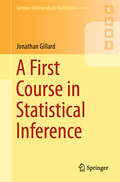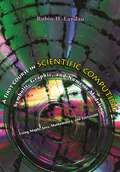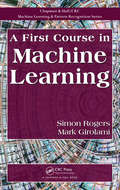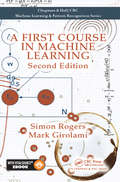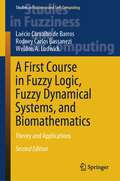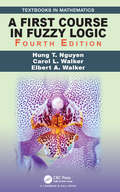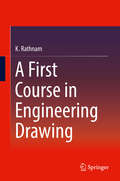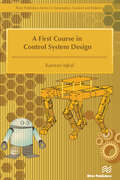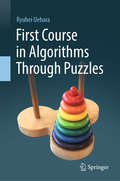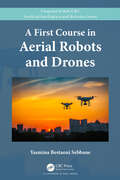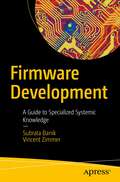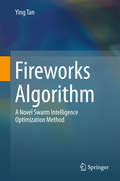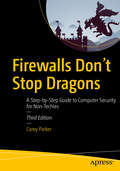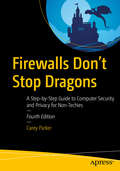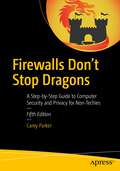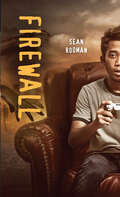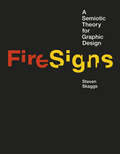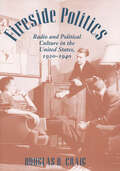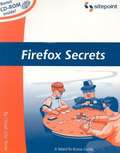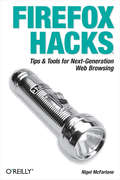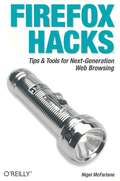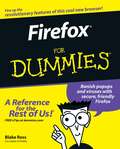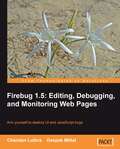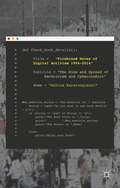- Table View
- List View
A First Course in Statistical Inference (Springer Undergraduate Mathematics Series)
by Jonathan GillardThis book offers a modern and accessible introduction to Statistical Inference, the science of inferring key information from data. Aimed at beginning undergraduate students in mathematics, it presents the concepts underpinning frequentist statistical theory.Written in a conversational and informal style, this concise text concentrates on ideas and concepts, with key theorems stated and proved. Detailed worked examples are included and each chapter ends with a set of exercises, with full solutions given at the back of the book. Examples using R are provided throughout the book, with a brief guide to the software included. Topics covered in the book include: sampling distributions, properties of estimators, confidence intervals, hypothesis testing, ANOVA, and fitting a straight line to paired data.Based on the author’s extensive teaching experience, the material of the book has been honed by student feedback for over a decade. Assuming only some familiarity with elementary probability, this textbook has been devised for a one semester first course in statistics.
A First Course in Scientific Computing: Symbolic, Graphic, and Numeric Modeling Using Maple, Java, Mathematica, and Fortran90
by Rubin LandauThis book offers a new approach to introductory scientific computing. It aims to make students comfortable using computers to do science, to provide them with the computational tools and knowledge they need throughout their college careers and into their professional careers, and to show how all the pieces can work together. Rubin Landau introduces the requisite mathematics and computer science in the course of realistic problems, from energy use to the building of skyscrapers to projectile motion with drag. He is attentive to how each discipline uses its own language to describe the same concepts and how computations are concrete instances of the abstract. Landau covers the basics of computation, numerical analysis, and programming from a computational science perspective. The first part of the printed book uses the problem-solving environment Maple as its context, with the same material covered on the accompanying CD as both Maple and Mathematica programs; the second part uses the compiled language Java, with equivalent materials in Fortran90 on the CD; and the final part presents an introduction to LaTeX replete with sample files. Providing the essentials of computing, with practical examples, A First Course in Scientific Computing adheres to the principle that science and engineering students learn computation best while sitting in front of a computer, book in hand, in trial-and-error mode. Not only is it an invaluable learning text and an essential reference for students of mathematics, engineering, physics, and other sciences, but it is also a consummate model for future textbooks in computational science and engineering courses. A broad spectrum of computing tools and examples that can be used throughout an academic career Practical computing aimed at solving realistic problems Both symbolic and numerical computations A multidisciplinary approach: science + math + computer science Maple and Java in the book itself; Mathematica, Fortran90, Maple and Java on the accompanying CD in an interactive workbook format
A First Course in Machine Learning
by Mark GirolamiA First Course in Machine Learning covers the core mathematical and statistical techniques needed to understand some of the most popular machine learning algorithms. The algorithms presented span the main problem areas within machine learning: classification, clustering and projection. The text gives detailed descriptions and derivations for a smal
A First Course in Machine Learning
by Simon Rogers Mark Girolami"A First Course in Machine Learning by Simon Rogers and Mark Girolami is the best introductory book for ML currently available. It combines rigor and precision with accessibility, starts from a detailed explanation of the basic foundations of Bayesian analysis in the simplest of settings, and goes all the way to the frontiers of the subject such as infinite mixture models, GPs, and MCMC."—Devdatt Dubhashi, Professor, Department of Computer Science and Engineering, Chalmers University, Sweden "This textbook manages to be easier to read than other comparable books in the subject while retaining all the rigorous treatment needed. The new chapters put it at the forefront of the field by covering topics that have become mainstream in machine learning over the last decade."—Daniel Barbara, George Mason University, Fairfax, Virginia, USA "The new edition of A First Course in Machine Learning by Rogers and Girolami is an excellent introduction to the use of statistical methods in machine learning. The book introduces concepts such as mathematical modeling, inference, and prediction, providing ‘just in time’ the essential background on linear algebra, calculus, and probability theory that the reader needs to understand these concepts."—Daniel Ortiz-Arroyo, Associate Professor, Aalborg University Esbjerg, Denmark "I was impressed by how closely the material aligns with the needs of an introductory course on machine learning, which is its greatest strength…Overall, this is a pragmatic and helpful book, which is well-aligned to the needs of an introductory course and one that I will be looking at for my own students in coming months."—David Clifton, University of Oxford, UK "The first edition of this book was already an excellent introductory text on machine learning for an advanced undergraduate or taught masters level course, or indeed for anybody who wants to learn about an interesting and important field of computer science. The additional chapters of advanced material on Gaussian process, MCMC and mixture modeling provide an ideal basis for practical projects, without disturbing the very clear and readable exposition of the basics contained in the first part of the book." —Gavin Cawley, Senior Lecturer, School of Computing Sciences, University of East Anglia, UK "This book could be used for junior/senior undergraduate students or first-year graduate students, as well as individuals who want to explore the field of machine learning…The book introduces not only the concepts but the underlying ideas on algorithm implementation from a critical thinking perspective."—Guangzhi Qu, Oakland University, Rochester, Michigan, USA
A First Course in Fuzzy Logic, Fuzzy Dynamical Systems, and Biomathematics: Theory and Applications (Studies in Fuzziness and Soft Computing #432)
by Rodney Carlos Bassanezi Weldon A. Lodwick Laécio Carvalho de BarrosThis book provides an essential introduction to the field of dynamical models. Starting from classical theories such as set theory and probability, it allows readers to draw near to the fuzzy case. On one hand, the book equips readers with a fundamental understanding of the theoretical underpinnings of fuzzy sets and fuzzy dynamical systems. On the other, it presents some concepts of derivatives, integrals and differential equations applied to the context of fuzzy functions. Each of the major topics is accompanied by examples, worked-out exercises, and exercises to be completed. Moreover, many applications to real problems are presented, mainly in biomathematics where the so-called p-fuzzy systems play an important role. The book has been developed on the basis of the authors’ lectures to university students and is accordingly primarily intended as a textbook for both upper-level undergraduates and graduates in applied mathematics, statistics, and engineering. It also offers a valuable resource for practitioners such as mathematical consultants and modelers, and for researchers alike, as it may provide both groups with new ideas and inspirations for projects in the fields of fuzzy logic and biomathematics. This thoroughly updated second edition includes a new chapter on fuzzy optimization, which also presents an application in carbon markets analysis and modeling
A First Course in Fuzzy Logic (Textbooks in Mathematics)
by Hung T. Nguyen Carol L. Walker Elbert A. Walker<p>A First Course in Fuzzy Logic, Fourth Edition is an expanded version of the successful third edition. It provides a comprehensive introduction to the theory and applications of fuzzy logic. <p>This popular text offers a firm mathematical basis for the calculus of fuzzy concepts necessary for designing intelligent systems and a solid background for readers to pursue further studies and real-world applications. <p>New in the Fourth Edition: <p> <li>Features new results on fuzzy sets of type-2 <li>Provides more information on copulas for modeling dependence structures <li>Includes quantum probability for uncertainty modeling in social sciences, especially in economics</li> <p>With its comprehensive updates, this new edition presents all the background necessary for students, instructors and professionals to begin using fuzzy logic in its many—applications in computer science, mathematics, statistics, and engineering. </p>
A First Course in Engineering Drawing
by K. RathnamThe primary objective of this book is to provide an easy approach to the basic principles of Engineering Drawing, which is one of the core subjects for undergraduate students in all branches of engineering. Further, it offers comprehensive coverage of topics required for a first course in this subject, based on the author's years of experience in teaching this subject. Emphasis is placed on the precise and logical presentation of the concepts and principles that are essential to understanding the subject. The methods presented help students to grasp the fundamentals more easily. In addition, the book highlights essential problem-solving strategies and features both solved examples and multiple-choice questions to test their comprehension.
A First Course in Electrical and Computer Engineering
by Louis ScharfElectrical and computer engineering textbook
A First Course in Control System Design
by Kamran IqbalControl systems are pervasive in our lives. Our homes have environmental controls. The appliances we use at home, such as the washing machine, microwave, etc. have embedded controllers. We fly in airplanes and drive automobiles, which make extensive use of control systems. The increasing automation in the past few decades has increased our reliance on control systems.A First Course in Control System Design discusses control systems design from a model-based perspective as applicable to single-input single-output systems. The emphasis in this book is on understanding and applying the techniques that enable the design of effective control systems. The book covers the time-domain and the frequency-domain design methods, as well as the design of continuous-time and discrete-time systems.Technical topics discussed in the book include: Modeling of physical systems Analysis of transfer function and state variable models Control system design via root locus Control system design in the state-space Control design of sampled-data systems Compensator design via frequency response modification
First Course in Algorithms Through Puzzles
by Ryuhei UeharaThis textbook introduces basic algorithms and explains their analytical methods. All algorithms and methods introduced in this book are well known and frequently used in real programs. Intended to be self-contained, the contents start with the basic models, and no prerequisite knowledge is required. This book is appropriate for undergraduate students in computer science, mathematics, and engineering as a textbook, and is also appropriate for self-study by beginners who are interested in the fascinating field of algorithms. More than 40 exercises are distributed throughout the text, and their difficulty levels are indicated. Solutions and comments for all the exercises are provided in the last chapter. These detailed solutions will enable readers to follow the author’s steps to solve problems and to gain a better understanding of the contents. Although details of the proofs and the analyses of algorithms are also provided, the mathematical descriptions in this book are not beyond the range of high school mathematics. Some famous real puzzles are also used to describe the algorithms. These puzzles are quite suitable for explaining the basic techniques of algorithms, which show how to solve these puzzles.
A First Course in Aerial Robots and Drones (Chapman & Hall/CRC Artificial Intelligence and Robotics Series)
by Yasmina Bestaoui SebbaneA First Course in Aerial Robots and Drones provides an accessible and student friendly introduction to aerial robots and drones. Drones figure prominently as opportunities for students to learn various aspects of aerospace engineering and design. Drones offer an enticing entry point for STEM studies. As the use of drones in STEM studies grows, there is an emerging generation of drone pilots who are not just good at flying, but experts in specific niches, such as mapping or thermography. Key Features: Focuses on algorithms that are currently used to solve diverse problems. Enables students to solve problems and improve their science skills. Introduces difficult concepts with simple, accessible examples. Suitable for undergraduate students, this textbook provides students and other readers with methods for solving problems and improving their science skills.
Firmware Development: A Guide to Specialized Systemic Knowledge
by Vincent Zimmer Subrata BanikBuild your own system firmware. This book helps you understand system firmware architecture and minimalistic design, and provides a specialized knowledge of firmware development. The book includes guidance on understanding the system firmware build procedure, integrating pieces of firmware and allowing configuration, updating system firmware, creating a development infrastructure for allowing multi-party collaboration in firmware development, and gaining advanced system firmware debugging knowledge.After reading the book you will be able to assume better control while developing your own firmware and know how to interact with native hardware while debugging. You will understand key principles for future firmware development using newer technology, and be ready for the introduction of modern safe programming languages for firmware development. Detailed system firmware development case studies using a futuristic approach cover:Future scalable system firmware development modelsTypes of firmware development (system firmware, device firmware, manageability firmware)Tools and their usage while creating system firmwareHow to build infrastructure for seamless firmware development using a multi-party development modelDebugging methodologies used during various phases of firmware product developmentSetting up key expectations for future firmware, including thinner firmware footprints and faster execution time, easier configuration, and increased transparent security What You Will LearnUnderstand the system firmware working model of the futureGain knowledge to say goodbye to proprietary firmware for different types of firmware developmentKnow the different types of tools required for creating firmware source code before flashing the final image into the boot device of the embedded systemDevelop skills to understand the failure in firmware or in the system and prepare the debugging environment to root cause the defectsDiscern the platform minimal security requirementOptimize the system firmware boot time based on the target hardware requirementComprehend the product development cycle using open source firmware development Who This Book Is For Embedded firmware and software engineers migrating the product development from closed source firmware to open source firmware for product adaptation needs as well as engineers working for open source firmware development. A secondary audience includes engineers working on various bootloaders such as open source firmware, UEFI, and Slim Bootloader development, as well as undergraduate and graduate students working on developing firmware skill sets.
Fireworks Algorithm
by Ying TanThis book is devoted to the state-of-the-art in all aspects of fireworks algorithm (FWA), with particular emphasis on the efficient improved versions of FWA. It describes the most substantial theoretical analysis including basic principle and implementation of FWA and modeling and theoretical analysis of FWA. It covers exhaustively the key recent significant research into the improvements of FWA so far. In addition, the book describes a few advanced topics in the research of FWA, including multi-objective optimization (MOO), discrete FWA (DFWA) for combinatorial optimization, and GPU-based FWA for parallel implementation. In sequels, several successful applications of FWA on non-negative matrix factorization (NMF), text clustering, pattern recognition, and seismic inversion problem, and swarm robotics, are illustrated in details, which might shed new light on more real-world applications in future. Addressing a multidisciplinary topic, it will appeal to researchers and professionals in the areas of metahuristics, swarm intelligence, evolutionary computation, complex optimization solving, etc.
Firewalls Don't Stop Dragons: A Step-by-Step Guide to Computer Security for Non-Techies
by Carey ParkerRely on this practical, end-to-end guide on cyber safety and online security written expressly for a non-technical audience. You will have just what you need to protect yourself—step by step, without judgment, and with as little jargon as possible. Just how secure is your computer right now? You probably don't really know. Computers and the Internet have revolutionized the modern world, but if you're like most people, you have no clue how these things work and don't know the real threats.Protecting your computer is like defending a medieval castle. While moats, walls, drawbridges, and castle guards can be effective, you'd go broke trying to build something dragon-proof. This book is not about protecting yourself from a targeted attack by the NSA; it's about armoring yourself against common hackers and mass surveillance. There are dozens of no-brainer things we all should be doing to protect our computers and safeguard our data—just like wearing a seat belt, installing smoke alarms, and putting on sunscreen. Author Carey Parker has structured this book to give you maximum benefit with minimum effort. If you just want to know what to do, every chapter has a complete checklist with step-by-step instructions and pictures. The book contains more than 150 tips to make you and your family safer. It includes: Added steps for Windows 10 (Spring 2018) and Mac OS X High SierraExpanded coverage on mobile device safetyExpanded coverage on safety for kids onlineMore than 150 tips with complete step-by-step instructions and pictures What You’ll LearnSolve your password problems once and for allBrowse the web safely and with confidenceBlock online tracking and dangerous adsChoose the right antivirus software for youSend files and messages securelySet up secure home networkingConduct secure shopping and banking onlineLock down social media accountsCreate automated backups of all your devicesManage your home computersUse your smartphone and tablet safelySafeguard your kids onlineAnd more! Who This Book Is For Those who use computers and mobile devices, but don’t really know (or frankly care) how they work. This book is for people who just want to know what they need to do to protect themselves—step by step, without judgment, and with as little jargon as possible.
Firewalls Don't Stop Dragons: A Step-by-Step Guide to Computer Security and Privacy for Non-Techies
by Carey ParkerRely on this practical, end-to-end guide on cyber safety and privacy written expressly for a non-technical audience. You will have just what you need to protect yourself—step by step, without judgment, and with as little jargon as possible. Just how secure is your computer right now? You probably don't know. Computers and the Internet have revolutionized the modern world, but if you are like most people, you have no clue how these things work and don't know the real threats.Protecting your computer is like defending a medieval castle. While moats, walls, drawbridges, and castle guards can be effective, you would go broke trying to build something dragon-proof. This book is not about protecting yourself from a targeted attack by the NSA; it is about arming yourself against common hackers and mass surveillance. There are dozens of no-brainer things we all should be doing to protect our computers and safeguard our data—just like wearing a seat belt, installing smoke alarms, and putting on sunscreen. Author Carey Parker has structured this book to give you maximum benefit with minimum effort. If you just want to know what to do, every chapter has a complete checklist with step-by-step instructions and pictures. This revised and expanded fourth edition contains more than 170 tips to make you and your family safer. It includes:Updates for Windows 10 (May 2020) and Mac OS 10.15 (Catalina)Updates for iOS 13 and Android 10Updated recommendations on the best apps, products, and servicesMore than 170 tips with complete step-by-step instructions and picturesA preview of Mac OS 11 Big Sur and iOS 14 What You Will LearnCreate killer passwords that you do not have to rememberBrowse the web safely and with confidenceProtect your data and reclaim your privacyShop and bank online with maximum securityDefend against identity theftProtect yourself from viruses and scamsMaximize your smartphone security and privacySafeguard your children onlineBlock online tracking and dangerous adsSend files and messages securely and privatelySet up secure home networkingKeep your smart devices from spying on youStop oversharing on social mediaCreate automated backups of all your devicesLearn how the Internet actually worksAnd more! Who This Book Is For Those who use computers and mobile devices, but do not know (or care) how they work. The book is for people who want to know what they need to do to protect themselves—step by step, without judgment, and with as little jargon as possible.
Firewalls Don't Stop Dragons: A Step-by-Step Guide to Computer Security and Privacy for Non-Techies
by Carey ParkerRely on this practical, comprehensive guide to significantly improve your cyber safety and data privacy. This book was written expressly for regular, everyday people -- though even technically savvy readers will find many useful tips here. This book contains everything you need to protect yourself-step by step, without judgment, and with as little jargon as possible. Protecting your digital domain is much like defending a medieval castle. Wide moats, towering walls and trained guards provide defense in depth, safeguarding the people and property within against the most common threats. But attempting to dragon-proof your castle would be counterproductive and costly. The goal of this book is to keep your devices and data safe from the most likely and impactful hazards - not a targeted attack by the NSA. Like wearing seat belts and sunscreen in the real world, there are dozens of simple, effective precautions we need to take in the virtual world. Author Carey Parker has structured this book to give you maximum benefit with minimum effort. If you just want to know what you need to do, each chapter includes a detailed checklist of expert tips. But the book also explains why you need to do these things, using entertaining analogies and straightforward explanations. This revised and expanded fifth edition includes: Updated for Windows 11, macOS 13 (Ventura), iOS 16 and Android 13. Updated recommendations for most secure and private products. Over 200 tips with complete step-by-step instructions and screenshots. What You Will Learn Maximize your computer and smartphone security. Minimize your vulnerabilities and data footprint. Solve your password problems and use two-factor authentication. Browse the web safely and confidently with a secure, private browser. Shop and bank online with maximum security and peace of mind. Defend against identity theft, ransomware and online scams. Safeguard your children online, at home and in school. Block online tracking, data mining and malicious online ads. Send files and messages with end-to-end encryption. Secure your home network and keep your smart devices from spying on you. Create automated backups of all your devices. Learn how to deal with account hacks, data. breaches and viruses. Understand how computers, the internet, VPNs and encryption really work And much more!
Firewall (Orca Soundings)
by Sean RodmanJosh is a gamer. After his parents' divorce and his move from Chicago to a small town where he doesn't know anybody, he copes by staying up way too late playing Killswitch online. Then he discovers a "mod" version of the game that is an exact reproduction of his new town. Strange things start to happen in the game, and they are somehow connected with events in the real world.
FireSigns: A Semiotic Theory for Graphic Design (Design Thinking, Design Theory)
by Steven SkaggsSemiotics concepts from a design perspective, offering the foundation for a coherent theory of graphic design as well as conceptual tools for practicing designers.Graphic design has been an academic discipline since the post-World War II era, but it has yet to develop a coherent theoretical foundation. Instead, it proceeds through styles, genres, and imitation, drawing on sources that range from the Bauhaus to deconstructionism. In FireSigns, Steven Skaggs offers the foundation for a semiotic theory of graphic design, exploring semiotic concepts from design and studio art perspectives and offering useful conceptual tools for practicing designers.Semiotics is the study of signs and significations; graphic design creates visual signs meant to create a certain effect in the mind (a “FireSign”). Skaggs provides a network of explicit concepts and terminology for a practice that has made implicit use of semiotics without knowing it. He offers an overview of the metaphysics of visual perception and the notion of visual entities, and, drawing on the pragmatic semiotics of the philosopher Charles Sanders Peirce, looks at visual experience as a product of the action of signs. He introduces three conceptual tools for analyzing works of graphic design—semantic profiles, the functional matrix, and the visual gamut—that allow visual “personality types” to emerge and enable a greater understanding of the range of possibilities for visual elements. Finally, he applies these tools to specific analyses of typography.
Fireside Politics: Radio and Political Culture in the United States, 1920–1940 (Reconfiguring American Political History)
by Douglas B. CraigAn “impressively researched and useful study” of the golden age of radio and its role in American democracy (Journal of American History).In Fireside Politics, Douglas B. Craig provides the first detailed and complete examination of radio’s changing role in American political culture between 1920 and 1940—the medium’s golden age, when it commanded huge national audiences without competition from television.Craig follows the evolution of radio into a commercialized, networked, and regulated industry, and ultimately into an essential tool for winning political campaigns and shaping American identity in the interwar period. Finally, he draws thoughtful comparisons of the American experience of radio broadcasting and political culture with those of Australia, Britain, and Canada.“The best general study yet published on the development of radio broadcasting during this crucial period when key institutional and social patterns were established.” ?Technology and Culture
Firefox Secrets
by Cheah Chu YeowThis is a must read guide to anyone who wants to learn how to browse faster and more conveniently with Firefox. Firefox Secrets will teach you how to get the most from Mozilla, including how to find and use all the hidden features, extensions available to you. You'll learn: Ways to ease the transition from Internet Explorer A way to setup multiple "homepages" when you launch your browser Read RSS feeds from within Firefox using a free extension Where to download a new and less obtrusive "Download Manager" The best "must-have" extensions to download as well as the "fun" ones Two different ways to speed up Firefox downloads with prefetcher and pipelining Firefox's secret features for Web Developers And much, much more! Firefox Secrets is the ultimate guide to the Web Browser that major magazines, newspapers and even Microsoft's own "Slate.com" website are recommending as the ultimate replacement to Internet Explorer.
Firefox Hacks
by Nigel McfarlaneFirefox Hacks is ideal for power users who want to take full advantage of Firefox from Mozilla, the next-generation web browser that is rapidly subverting Internet Explorer's once-dominant audience. It's also the first book that specifically dedicates itself to this technology. Firefox is winning such widespread approval for a number of reasons, including the fact that it lets users browse faster and more efficiently. Perhaps its most appealing strength, though, is its increased security something that is covered in great detail in Firefox Hacks. Clearly the web browser of the future, Firefox includes most of the features that browser users are familiar with, along with several new features, such as a bookmarks toolbar and tabbed pages that allow users to quickly switch among several web sites. Firefox Hacks offers all the valuable tips and tools you need to maximize the effectiveness of this hot web application. It's all covered, including how to customize its deployment, appearance, features, and functionality. You'll even learn how to install, use, and alter extensions and plug-ins. Aimed at clever people who may or may not be capable of basic programming tasks, this convenient resource describes 100 techniques for 100 strategies that effectively exploit Firefox. Or, put another way, readers of every stripe will find all the user-friendly tips, tools, and tricks they need to make a productive switch to Firefox. With Firefox Hacks, a superior and safer browsing experience is truly only pages away. The latest in O'Reilly's celebrated Hacks series, Firefox Hacks smartly complements other web-application titles such as Google Hacks and PayPal Hacks.
Firefox Hacks
by Nigel McfarlaneFirefox Hacks is ideal for power users who want to take full advantage of Firefox from Mozilla, the next-generation web browser that is rapidly subverting Internet Explorer's once-dominant audience. It's also the first book that specifically dedicates itself to this technology. Firefox is winning such widespread approval for a number of reasons, including the fact that it lets users browse faster and more efficiently. Perhaps its most appealing strength, though, is its increased security something that is covered in great detail in Firefox Hacks . Clearly the web browser of the future, Firefox includes most of the features that browser users are familiar with, along with several new features, such as a bookmarks toolbar and tabbed pages that allow users to quickly switch among several web sites. Firefox Hacks offers all the valuable tips and tools you need to maximize the effectiveness of this hot web application. It's all covered, including how to customize its deployment, appearance, features, and functionality. You'll even learn how to install, use, and alter extensions and plug-ins. Aimed at clever people who may or may not be capable of basic programming tasks, this convenient resource describes 100 techniques for 100 strategies that effectively exploit Firefox. Or, put another way, readers of every stripe will find all the user-friendly tips, tools, and tricks they need to make a productive switch to Firefox. With Firefox Hacks , a superior and safer browsing experience is truly only pages away. The latest in O'Reilly's celebrated Hacks series, Firefox Hacks smartly complements other web-application titles such as Google Hacks and PayPal Hacks .
Firefox For Dummies
by Blake RossFirefox For Dummies gives you the inside scoop on the exciting new browser from the Web wizard that got it started. The book's author, Blake Ross, began developing Firefox as a teenager. Once available to the world, the simple and powerful tool was an instant hit claiming a sizable share of the Web browser market with over 140 million downloads. In this book Blake not only gives you the lowdown on how to use Firefox for safe Web searching, but he also shares his insight into how the product came to life. It's a combination of practical tech insight and a good story that is rare in computer books. Topics covered include downloading and installing Firefox, creating a home page, searching with Google, creating customized themes and toolbars, using tabbed browsing, downloading and saving files, maintaining security and privacy, eliminating annoying popups, and adding Firefox extensions.
Firebug 1.5: Editing, Debugging, and Monitoring Web Pages
by Chandan Luthra Deepak MittalA step-by-step description of each key feature is provided with the help of simple, easy-to-understand examples. There are plenty of useful screenshots in each chapter. Every chapter contains information as well as tips and tricks to draw your attention towards some useful information or reference. Each aspect of web development like CSS or JavaScript is handled independently so that you can refer to those modules in which you are interested. This book is written for frontend web developers building software and pages using HTML, CSS, JavaScript, and AJAX, who want to learn Firebug for the reasons outlined above. The book assumes that readers have a very basic knowledge of HTML, JavaScript, and CSS. The examples in the book can be understood by someone who has just been introduced to web development.
Firebrand Waves of Digital Activism 1994–2014: The Rise and Spread of Hacktivism and Cyberconflict
by Athina KaratzogianniFirebrand Waves of Digital Activism 1994–2014.
